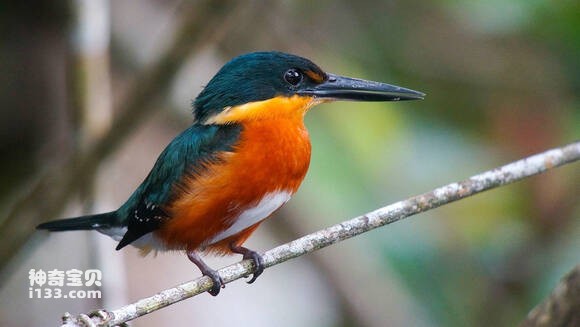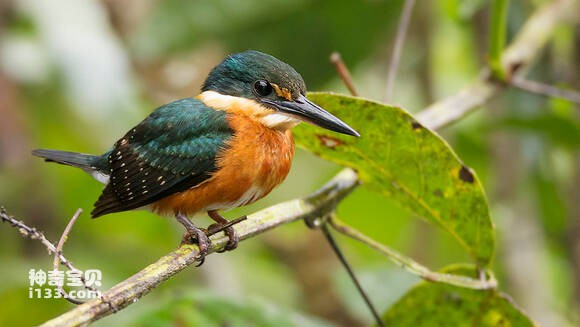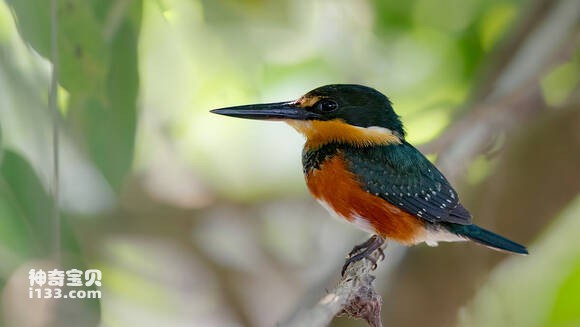Chloroceryle aenea
IUCN
LCBasic Information
Scientific classification
- name:Chloroceryle aenea
- Scientific Name:Chloroceryle aenea,Pygmy Kingfisher
- Outline:Climbing birds
- Family:
Vital signs
- length:About 13 cm
- Weight:No textual research information is available
- lifetime:No textual research information is available
Feature
Distribution and Habitat
The slow green dog is found in Central America (between North and South America, Including Guatemala, Belize, Honduras, El Salvador, Nicaragua, Costa Rica, Panama, Bahamas, Cuba, Haiti, Jamaica, Dominica, Antigua and Barbuda, Saint Vincent and the Grenadines, Saint Lucia, Barbados, Grenada, Trinidad and Tobago, etc.), South America (including Colombia, Venezuela, Guyana, Suriname, Ecuador, Peru, Bolivia, Paraguay, Brazil, Chile, Argentina, Uruguay and the Malvinas Islands (also known as the Falkland Islands)).
The slow green dog is often found in forests in dense areas of streams, ponds and rivers, mangroves and rainforests. It is very common, although its distribution and its density are very uneven across its distribution area. It can also be seen as high as 1800 meters.
Appearance
Pygmy dog The Pygmy dog is 13 cm long. An adult male with a dark green glossy golden forehead at the top. The tail is blue-green. The eyes are black first, with a signature short white line at the bottom of the eye. A red collar forms a unified whole at the throat. Back and wings dark blue. The chest and sides of the lower body are reddish in tone, contrasting with the white underbelly and white tail. Lower wing light change shows orange tone. Black mouth, yellow mandibular base. Iris dark brown, legs dark gray.
The adult female differs from the male in the dark green broad band of the chest, with white plumage. Young birds are paler and darker than adults. There are more spots on the wings. Half of the birds have dark green stripes on the chest and wings. The breast band of the female half of the adult bird is narrower than that of the adult and is often discontinuous.
Mouth long and flat side, peak ridge round; Nasal sulci was significant; The wingtip of the first primary feath
Details
Chloroceryle aenea, also known as Pygmy Kingfisher, has two subspecies (1.Chloroceryle aenea stictoptera is found in Gustaja, southern Mexico (Puebla, Veracruz). 2.Chloroceryle aenea is found in Colombia, Gustaja, Andean, Ecuador, Venezuela, Ecuador, Peru, Bolivia, Paraguay, Argentina, and Trinidad, Brazil.) .

The pygmy dog is a fish-eating kingfisher with excellent dive diving skills and can even hover in the air to lock on to its target. They live mainly by the river and fish for a living. It lives in brush or open forest, clear and slow-flowing rivers, streams, lakes and irrigation canals. It often flies over rivers, streams, ponds and swamps looking down for food. As soon as you spot food, make a quick dive. Usually live alone on the top of a tree branch near the water, the top of a telephone pole or on a rock, waiting for an opportunity to hunt. It usually squatts on the low branches and stones near the water, waiting for bait. The method of hunting is the same as that of the kingfisher, which often preys on the surface of the water or dives into the water to hunt. Sometimes they can even disappear completely under water; Sometimes it flaps its wings and stops flying in the air about 3-10 meters from the water, as if hanging on the water, and when it sees the prey, it immediately dives into the water to hunt it. It puts the catch on the perch, and keeps fiddling with it, and even throws the fish up in order to swallow the fish from the head first. The food is mainly small fish, and eats crustaceans and a variety of aquatic insects and their larvae, but also pecks at small frogs and a few aquatic plants.

The spawning season is May in El Salvador and Suriname, and from May to August or September in Trinidad and Tobago. The nest is built on earth cliffs, or in the dykes of fields and streams and rivers, and the nest is dug with the mouth in a 30-40 cm long tunnel type cave, which is generally not covered with bedding. The eggs are laid directly on the nest ground. They also sometimes occupy termite hollow trees for nests. Egg color pure white, bright, solid shell, slightly spotted.

Listed in the International Union for Conservation of Nature (IUCN) ver 3.1:2008 Red List of Birds.
Protect wild animals and eliminate wild meat.
Maintaining ecological balance is everyone's responsibility!








